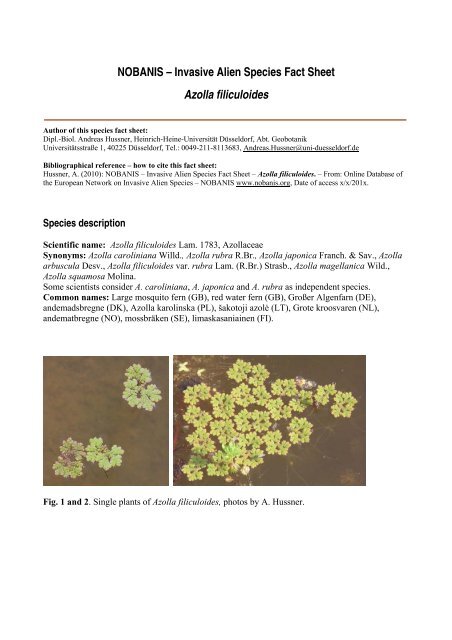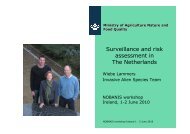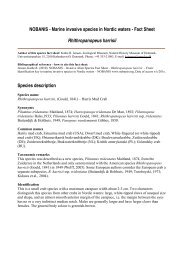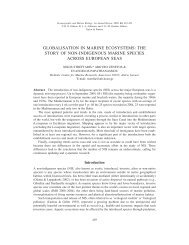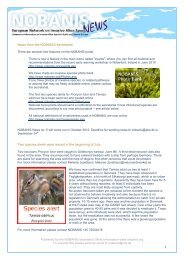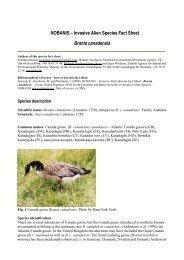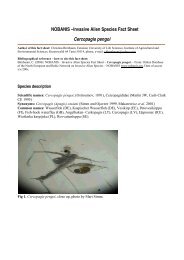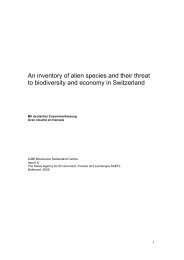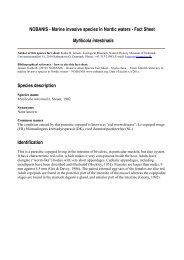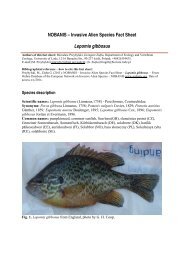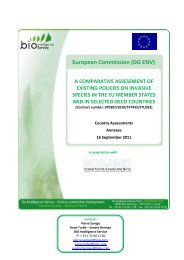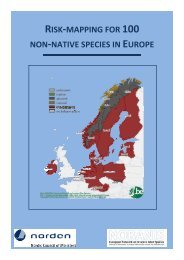Azolla filiculoides - NOBANIS
Azolla filiculoides - NOBANIS
Azolla filiculoides - NOBANIS
Create successful ePaper yourself
Turn your PDF publications into a flip-book with our unique Google optimized e-Paper software.
<strong>NOBANIS</strong> – Invasive Alien Species Fact Sheet<br />
<strong>Azolla</strong> <strong>filiculoides</strong><br />
Author of this species fact sheet:<br />
Dipl.-Biol. Andreas Hussner, Heinrich-Heine-Universität Düsseldorf, Abt. Geobotanik<br />
Universitätsstraße 1, 40225 Düsseldorf, Tel.: 0049-211-8113683, Andreas.Hussner@uni-duesseldorf.de<br />
Bibliographical reference – how to cite this fact sheet:<br />
Hussner, A. (2010): <strong>NOBANIS</strong> – Invasive Alien Species Fact Sheet – <strong>Azolla</strong> <strong>filiculoides</strong>. – From: Online Database of<br />
the European Network on Invasive Alien Species – <strong>NOBANIS</strong> www.nobanis.org, Date of access x/x/201x.<br />
Species description<br />
Scientific name: <strong>Azolla</strong> <strong>filiculoides</strong> Lam. 1783, <strong>Azolla</strong>ceae<br />
Synonyms: <strong>Azolla</strong> caroliniana Willd., <strong>Azolla</strong> rubra R.Br., <strong>Azolla</strong> japonica Franch. & Sav., <strong>Azolla</strong><br />
arbuscula Desv., <strong>Azolla</strong> <strong>filiculoides</strong> var. rubra Lam. (R.Br.) Strasb., <strong>Azolla</strong> magellanica Wild.,<br />
<strong>Azolla</strong> squamosa Molina.<br />
Some scientists consider A. caroliniana, A. japonica and A. rubra as independent species.<br />
Common names: Large mosquito fern (GB), red water fern (GB), Großer Algenfarn (DE),<br />
andemadsbregne (DK), <strong>Azolla</strong> karolinska (PL), šakotoji azolė (LT), Grote kroosvaren (NL),<br />
andematbregne (NO), mossbräken (SE), limaskasaniainen (FI).<br />
Fig. 1 and 2. Single plants of <strong>Azolla</strong> <strong>filiculoides</strong>, photos by A. Hussner.
Fig. 3 and 4. Thin and dense mats of <strong>Azolla</strong> <strong>filiculoides</strong>, photos by A. Hussner.<br />
Fig. 5. <strong>Azolla</strong> <strong>filiculoides</strong> plants in a heated pond in winter; the plants become red with an<br />
increasing distance from the heater, photo by A. Hussner.<br />
2
Species identification<br />
A. <strong>filiculoides</strong> is a heterosporous, up to 2.5 (10) cm large floating fern (Figs. 1-5). <strong>Azolla</strong> plants are<br />
polygonal or triangular in shape (Lumpkin and Plucknett 1980). The sporophytes consist of twolobed<br />
leaves and rhizomes. The lower lobes of the leaves are usually larger than the upper. Svenson<br />
(1944) described the lower lobes as so adapted for floating the plant, that only the lower surface of<br />
these lower lobes comes in contact with water.<br />
The plants are dark green to reddish and float on the water surface, either individually or in mats,<br />
which can reach a thickness of up to 20 cm (McConnachie et al. 2004). A characteristic of the<br />
genus <strong>Azolla</strong> is the symbiotic relationship with the nitrogen-fixing blue-green alga Anabaena<br />
azollae. When A. <strong>filiculoides</strong> plants are exposed to strong sunlight they obtain a red colour. The<br />
same occurs in wintertime. In shade they always remain green (Moore 1953, Janes 1998a). Janes<br />
(1998a) described three different phenotypes of A. <strong>filiculoides</strong> under different habitat and climate<br />
conditions.<br />
Native range<br />
A. <strong>filiculoides</strong> is native to warm temperate and subtropical America through Western North<br />
America (including Alaska). West (1953) described A. <strong>filiculoides</strong> furthermore as a species which<br />
in former times was native to Europe (Ekman 1998, 1999, O`Brien and Jones 2003), but died out<br />
during the last Ice Ages.<br />
Alien distribution<br />
History of introduction and geographical spread<br />
A. <strong>filiculoides</strong> has actually become a cosmopolitan plant, with occurrences in South Africa (Hill and<br />
Cilliers 1999, Gratwicke and Marshall 2001, McConnachie et al. 2003, 2004), Asia (Ahmad 1941,<br />
1943, Kitoh et al. 1993), Australia, South-, Central- and North America (Svenson 1944), South-,<br />
West-, Central- and North Europe (West 1953, Birkenbeil 1974, Bernhardt 1991, Kohler 1995,<br />
Ferreira et al. 1998, Janes 1998a, b, Hussner and Lösch 2005) and Scandinavia (Rune and<br />
Jørgensen 1997). The species was introduced to Europe in 1880 near Bordeaux (West 1953). First<br />
plants were reported from France, and since then the species spread to nearly the whole of Europe<br />
with a main occurrence in Atlantic-Mediterranean regions.<br />
Pathways of introduction<br />
A. <strong>filiculoides</strong> is able to reach new regions by waterfowls, in ballast tanks of ships, or by human<br />
influence (intentionally or unintentionally). Discharge by aquarium keepers may play an important<br />
role in spread of this species. Rune and Jørgensen (1997) described two examples of intentional<br />
releases of A. <strong>filiculoides</strong> plants in Denmark.<br />
Alien status in region<br />
A. <strong>filiculoides</strong> is an alien plant to Europe and Scandinavia (see table 1). In Germany A. <strong>filiculoides</strong><br />
is common (Birkenbeil 1974, Bernhardt 1991, Kohler 1995, Jaeger and Werner 2002, Kowarik<br />
2003, Hussner and Lösch 2005), but there are no reports on such thick mats as they are reported<br />
from other countries (McConnachie et al. 2003). Rune and Jørgensen (1997) described A.<br />
<strong>filiculoides</strong> from 11 different sites in Denmark. A.<strong>filiculoides</strong> is found in a few localities in Southern<br />
Sweden. It is uncertain if A. <strong>filiculoides</strong> is established or if occurrences are incidental.<br />
In Poland the species is known from some ephemeral locations in the SW and NE regions<br />
(Rostański and Sowa 1986-1987, Wokowycki 1999). In Lithuania A. <strong>filiculoides</strong> was recorded<br />
abundantly growing in an exploited peatbog in 1946, later became extinct (Gudžinskas 2000). In<br />
3
Norway it has been recorded from three different locations; Oslo (1927 and later), Klepp in the SW<br />
(1995) and Stokke in the SE (2001). The species is so far apparently not able to survive the winters<br />
in Norway.<br />
Country Not Not Rare Local Common Very Not<br />
found established<br />
common known<br />
Austria X<br />
Belgium X<br />
Czech republic X<br />
Denmark X<br />
Estonia X<br />
European part of Russia X<br />
Finland X<br />
Faroe Islands X<br />
Germany X<br />
Greenland X<br />
Iceland X<br />
Ireland X<br />
Latvia X<br />
Lithuania X<br />
Netherlands X<br />
Norway X<br />
Poland X<br />
Slovakia X<br />
Sweden X<br />
Table 1. The frequency and establishment of <strong>Azolla</strong> <strong>filiculoides</strong>, please refer also to the information<br />
provided for this species at www.nobanis.org/search.asp. Legend for this table: Not found - The<br />
species is not found in the country; Not established - The species has not formed self-reproducing<br />
populations (but is found as a casual or incidental species); Rare - Few sites where it is found in the<br />
country; Local - Locally abundant, many individuals in some areas of the country; Common -<br />
Many sites in the country; Very common - Many sites and many individuals; Not known - No<br />
information was available.<br />
Ecology<br />
Habitat description<br />
A. <strong>filiculoides</strong> settles in ponds, ditches, water reservoirs, wetlands, channels and slow flowing<br />
rivers. A. <strong>filiculoides</strong> can be found in sunny to shady parts of the water bodies. Through its<br />
symbiotic association with Anabaena azollae, the floating fern is able to grow in nitrogen-deficient<br />
waters. Kitoh et al. (1993) observed that less phosphorous can limit the growth of the species.<br />
The species grows at best at 15-20°C and high irradiance (Tung and Watanabe 1983, Watanabe and<br />
Berja 1983, Janes 1998a). Wong et al. (1987) stated that optimum temperature for both nitrogen<br />
fixation and oxygen evolution is 25°C. Janes (1998a) reported that plants die under laboratory<br />
conditions at temperatures below – 4°C. Janes (1998a) described A. <strong>filiculoides</strong> as the most frost<br />
tolerant of the <strong>Azolla</strong> species. Wong et al. (1987) reported that A. <strong>filiculoides</strong> withstands field<br />
temperatures of – 10 to – 15°C. Janes (1998a) observed successfully overwintered vegetative plants<br />
4
in Worcester (UK) where the minimum air temperature reached – 10°C. Janes (1998a) described<br />
that plants are able to survive encasement in ice for at least one week, but those parts of the plants<br />
which protruded above the ice, were killed.<br />
Reproduction and life cycle<br />
A. <strong>filiculoides</strong> has a surface-area doubling time of 7-10 days under favourable conditions. Kitoh et<br />
al. (1993) observed a doubling of the biomass every 2.2 – 3.4 days under laboratory conditions. The<br />
growth rate of A. <strong>filiculoides</strong> increased with increased photoperiod. Janes (1998a, b) investigated<br />
the sporulation and germination of A. <strong>filiculoides</strong> and showed that the species sporulates regularly at<br />
many sites in Britain, most often between May and November. From Germany sporulating plants<br />
are known too (pers. obs.). It seems that sporulation of this species is regulated by the interacting<br />
effects of light intensity, photoperiod, temperature, pH and nutrient availability. Janes (1998b)<br />
suggested that a thick mat of 8 kg m -2 fresh biomass may produce 85 000 megasporocarps and 380<br />
000 microsporocarps. In laboratory experiments a maximum of germination was reached at 20°C,<br />
but at a constant temperature of 5°C no germination was observed (Janes 1998b). For germination a<br />
temperature above 10°C and light are necessary. Temperatures of about – 10°C for at least 18 days<br />
had no influence on further germination of the sporocarps. The heterosporous life cycle of the genus<br />
<strong>Azolla</strong> is illustrated in Fig. 6.<br />
Fig. 6. Heterosporous life cycle of <strong>Azolla</strong> (redrawn from Lumpkin and Plucknett 1980)<br />
Dispersal and spread<br />
A. <strong>filiculoides</strong> can spread locally by waterfowls, water sport tackle (diving, fishing, water skiing<br />
etc.) or by discharge from aquarium keepers.<br />
Impact<br />
Affected habitats and indigenous organisms<br />
A. <strong>filiculoides</strong> settles in ponds, ditches, water reservoirs, channels and slow flowing rivers. In some<br />
cases the species can be found together with Lemna minuta, Lemna minor and Spirodela polyrhiza.<br />
In other cases A. <strong>filiculoides</strong> forms dense monospecific mats. These mats of floating plants can<br />
affect the water by eliminating submerged plants and algae (Janes et al. 1996), preventing their<br />
photosynthesis and blocking oxygen diffusion. Also populations of animals are reduced in the water<br />
beneath the mats (Gratwicke and Marshall 2001).<br />
5
Genetic effects<br />
Janes (1998b) reported that there is some evidence that A. <strong>filiculoides</strong> might have adapted to the<br />
British climate since its introduction. Similar adaptations are possible for the population in other<br />
countries.<br />
Human health effects<br />
There are no human health effects known.<br />
Economic and societal effects (positive/negative)<br />
The genus <strong>Azolla</strong> is useful in rice fields, because it can assimilate atmospheric nitrogen gas owing<br />
to the nitrogen fixation by cyanobacteria (blue green alga) living in the cavities located at the lower<br />
side of upper (dorsal) lobes of leaf. By this, <strong>Azolla</strong> is used as a green manure in rice fields in Asia<br />
since several decennia (Moore 1969, Mandal et al. 1999, Choudhury and Kennedy 2004, De Macale<br />
and Vlek 2004, Nayak et al. 2004, Kimura 2005). Aside from this fertilizing effect in cultivation of<br />
rice, <strong>Azolla</strong> may influence the pH of the water (Vlek et al. 2002). Shiomi and Kitoh (2001),<br />
Parthasarathy et al. (2002) and Reyes and Fermin (2003) described the use of <strong>Azolla</strong> as a feed for<br />
animals, particularly for fishes.<br />
In the last years the genus <strong>Azolla</strong> has become more and more important in wastewater treatments to<br />
eradicate different metals or to remove nitrogenous compounds from the water (Ghobrial and Siam<br />
1998, Sanyahumi et al. 1998, Zhao and Duncan 1998, Costa et al. 1999, Zhao et al. 1999 a, b,<br />
Allison et al. 2000, Forni et al. 2001a, b, 2002, Cohen-Shoel et al. 2002, Oren Benaroya et al. 2004,<br />
Shiny et al. 2004, Gardea et al. 2005, Stepniewska et al. 2005).<br />
On the other hand, <strong>Azolla</strong> can form such dense and thick mats, that it may be impossible to row a<br />
boat through it (Moore 1969). <strong>Azolla</strong> mats can reduce the population of different animals from<br />
water beneath the mats (Gratwicke and Marshall 2001), and furthermore submerged plants can be<br />
eradicated by shading (Janes et al. 1996).<br />
Management approaches<br />
Prevention methods<br />
Prevention methods are not known.<br />
Eradication, control and monitoring efforts<br />
Control options for A. <strong>filiculoides</strong> are limited. Due to a surface-area doubling time of 7-10 days,<br />
mechanical control is impractical. Hill and Cilliers (1999) considered manual, mechanical and<br />
herbicidal control as undesirable and only small infestations of <strong>Azolla</strong> can be removed manually<br />
using fine meshed nets. Barreto et al. (2000) described the biological control of <strong>Azolla</strong> with fungi.<br />
Hill (1998), Hill and Cilliers (1999) and McConnachie et al. (2003, 2004) described a successful<br />
biological control of bigger occurrences by the frond-feeding weevil Stenopelmus rufinasus in<br />
South Africa, where A. <strong>filiculoides</strong> covered dams and water reservoirs.<br />
Education and awareness<br />
No information available.<br />
Knowledge and research<br />
6
There is a broad knowledge about the biology and physiology of A. <strong>filiculoides</strong>. Since several<br />
decennia scientists around the world have investigated the genus <strong>Azolla</strong>. Moore (1969) and<br />
Lumpkin and Plucknett (1980) have made excellent reviews of literature. In the last years the<br />
control of A. <strong>filiculoides</strong> has gained more and more importance (McConnachie et al. 2003, 2004). In<br />
addition the research about bioaccumulation and phytoremediation has received high interest in the<br />
science of wastewater treatment (Ghobrial and Siam 1998, Sanyahumi et al. 1998, Zhao and<br />
Duncan 1998, Zhao et al. 1999 a, b, Forni et al. 2001, 2002, Cohen-Shoel et al. 2002, Oren<br />
Benaroya et al. 2004, Shiny et al. 2004, Gardea et al. 2005, Stepniewska et al. 2005).<br />
Recommendations or comments from experts and local communities<br />
A comprehensive investigation of actual distribution and involved water bodies will be helpful for<br />
an estimation of the further spread of this species in our region.<br />
References and other resources<br />
Contact persons<br />
Franz Essl (AT), Umweltbundesamt, Naturschutz, Spittelauer Lände 5, 1090 Wien, Austria<br />
E-mail: franz.essl@umweltbundesamt.at<br />
Andreas Hussner (DE), Heinrich-Heine-Universität Düsseldorf, Department of Geobotany,<br />
Universitätsstraße 1, DE-40225 Düsseldorf. Tel.: 0049-211-8113683, E-mail:<br />
Andreas.Hussner@uni-duesseldorf.de<br />
Melanie Josefsson (SE) Swedish Environmental Protection Agency, SE 106 48 Stockholm, Tel:<br />
+46 8 698 1541, E-mail: Melanie.Josefsson@snv.slu.se<br />
Christina Birnbaum (EE), Estonian University of Life Sciences, Institute of Agriculture and<br />
Environmental Sciences, Kreutzwaldi 64, Tartu 51014. E-mail: chbirnbaum@yahoo.com<br />
Colette O'Flynn (IE), National Biodiversity Data Centre, WIT West campus, Carriganore,<br />
Waterford, Ireland. E-mail: coflynn@biodiversityireland.ie<br />
Dan Wołkowycki (PL) Białystok Technical University, Division of Environmental Protection and<br />
Management, ul. Wiejska 45E, 15-351 Bialystok, Poland, Tel. 0048 85 746 9658 , E-mail:<br />
danwolko@pb.edu.pl<br />
Henrik Jørgensen (DK), Danish Forest and Nature Agency, Ministry of the Environment,<br />
Haraldsgade 53, DK-2100 Copenhagen Ø. Phone: +45 3947 2000, E-mail: hjg@sns.dk<br />
Links<br />
Aquatic neophytes – in German<br />
Flora of Northern Ireland – fact sheet on <strong>Azolla</strong> <strong>filiculoides</strong><br />
Canadas Plant Species – <strong>Azolla</strong> <strong>filiculoides</strong> incl. distribution map<br />
Biological Control of Red Water Fern in South Africa - report<br />
7
<strong>Azolla</strong> in USA<br />
References<br />
Ahmad, G. (1941): Effect of light intensity and temperature on the growth of <strong>Azolla</strong> <strong>filiculoides</strong>. Journal of the Indian<br />
Botanical Society 20: 213-226<br />
Ahmad, G. (1943): Interrelationship between the compensation point, temperature coeffient and growth of <strong>Azolla</strong><br />
<strong>filiculoides</strong>. Journal of the Indian Botanical Society 22-23: 101-104<br />
Allison, G., Stagnitti, F., Colville, S., Hill, J. and Coates, M. (2000): Growth of floating aquatic macrophytes in alkaline<br />
industrial wastewaters. Journal of Environmental Engineering 126: 1103-1107<br />
Barreto, R., Charudattan, R., Pomella, A. and Hanada, R. (2000): Biological control of neotropical aquatic weeds with<br />
fungi. Crop Protection 19: 697-703<br />
Bernhardt, K.G. (1991): Zur aktuellen Verbreitung von <strong>Azolla</strong> <strong>filiculoides</strong> Lam. (1783) and <strong>Azolla</strong> caroliniana Willd.<br />
(1810) in Nordwestdeutschland. Floristische Rundbriefe 25: 14-19<br />
Birkenbeil, H. (1974): <strong>Azolla</strong> <strong>filiculoides</strong> Lam. im Nordheimer Altrhein. Hessische Floristische Briefe 23: 14-16<br />
Cohen-Shoel, N., Barkay, Z., Ilzycer, D., Gilath, I. and Tel-Or, E. (2002): Biofiltration of toxic elementary by <strong>Azolla</strong><br />
biomass. Water, Air, and Soil Pollution 135 (1-4): 93-104<br />
Costa, M.L., Santos, M.C. and Carrapico, F. (1999): Biomass characterization of <strong>Azolla</strong> <strong>filiculoides</strong> grown in natural<br />
ecosystems and wastewater. Hydrobiologia 415: 323-327<br />
De Macale, M.A.R., Vlek, P.L.G. (2004): The role of <strong>Azolla</strong> cover in improving the nitrogen use efficiency of lowland<br />
rice. Plant and Soil 263 (1-2): 311-321<br />
Ekman, S.R. (1998): Pleistocene pollen stratigraphy from borehole 81/34, Devil’s hole area, central North Sea.<br />
Quaternary Science Reviews 17: 855-869<br />
Ekman, S.R. (1999): Early Pleistocene pollen biostratigraphy in the central North Sea. Review of Palaeobotany and<br />
Palynology 105: 171-182<br />
Ferreira, M.T., Catarino, L. and Moreira, I. (1998): Aquatic weed assemblages in an Iberian drainage channel system<br />
and related environmental factors. Weed research 38(4): 291-300<br />
Forni, C., Chen, J., Pancioni, L. and Grilli Caiola, M. (2001a): Evaluation of the fern <strong>Azolla</strong> for growth, nitrogen and<br />
phosphorous removal from wastewater. Water research 35 (6): 1592-1598<br />
Forni, C., Nicolai, M.A. and D’Egidio, M.G. (2001b): Potential of the small aquatic plants <strong>Azolla</strong> and Lemna for<br />
nitrogenous compounds removal from wastewater. Progress in Water Resources: 315-324<br />
Forni, C., Cascone, A., Fiori, M. and Migliore, L. (2002): Sulphadimethoxine and <strong>Azolla</strong> <strong>filiculoides</strong> Lam.: A model for<br />
drug remediation. Water research 36 (13): 3398-3403<br />
Gardea-Torresdey, J.L., Peralta-Videa, J.R., De La Rosa, G. and Parsone, J.G. (2005): Phytoremediation of heavy<br />
metals and study of the metal coordination by X-ray absorption spectroscopy. Coordination Chemistry Reviews 249:<br />
1797-1810<br />
Ghobrial, M.G. and Siam, E.E. (1998): The use of the water velvet <strong>Azolla</strong> <strong>filiculoides</strong> in wastewater treatment. Journal<br />
of the Chartered Institution of Water and Environmental Management 12 (4): 250-253<br />
Gratwicke, B. and Marshall, B.E. (2001): The impact of <strong>Azolla</strong> <strong>filiculoides</strong> Lam. on animal biodiversity in streams in<br />
Zimbabwe. African Journal of Ecology 39 (2): 216-218<br />
8
Gudžinskas, Z. (2000): Conspectus of alien plant species of Lithuania. 15. <strong>Azolla</strong>ceae, Pinaceae, and Salicaceae.<br />
Botanica Lithuanica, 6 (3): 235–242<br />
Hill, M.P. (1998): Life history and laboratory host range of Stenopelmus rufinasus, a natural enemy for <strong>Azolla</strong><br />
<strong>filiculoides</strong> in South-Africa. BioControl 43 (2): 215-224<br />
Hill, M.P. and Cilliers, C.J. (1999): <strong>Azolla</strong> <strong>filiculoides</strong> Lamarck (Pteridophyta: <strong>Azolla</strong>ceae), its status in South Africa<br />
and control. Hydrobiologia 415: 203-206<br />
Hussner, A. and Lösch, R. (2005): Alien aquatic plants in a thermally abnormal river and their assembly to neophytedominated<br />
macrophyte stands (River Erft, Northrhine-Westphalia). Limnologica 35: 18-30<br />
Jaeger, E. and Werner, K. (2002): Rothmaler, Exkursionsflora von Deutschland. Band 4, Gefäßpflanzen, kritischer<br />
Band, 9. Auflage, Spektrum, Heidelberg/Berlin<br />
Janes, R. (1998a): Growth and survival of <strong>Azolla</strong> <strong>filiculoides</strong> in Britain. 1. Vegetative reproduction. New Phytologist<br />
138: 367-376<br />
Janes, R. (1998b): Growth and survival of <strong>Azolla</strong> <strong>filiculoides</strong> in Britain. 2. Sexual reproduction. New Phytologist 138:<br />
377-384<br />
Janes, R., Eaton, J.W. and Hardwick, K. (1996): The effects of floating mats of <strong>Azolla</strong> <strong>filiculoides</strong> Lam. and Lemna<br />
minuta Kunth on the growth of submerged macrophytes. Hydrobiologia 340: 23-26<br />
Kimura, M. (2005): Populations, community composition and biomass of aquatic organism in the floodwater of rice<br />
fields and effects of field management. Soil Science and Plant Nutrition 51 (2): 159-181<br />
Kitoh, S., Shiomi, N. and Uheda, E. (1993): The growth and nitrogen fixation of <strong>Azolla</strong> <strong>filiculoides</strong> Lam. in polluted<br />
water. Aquatic botany 46: 129-139<br />
Kohler, A. (1995): Neophyten in Fließgewässern – Beispiele aus Süddeutschland und dem Elsaß. Schriftenreihe für<br />
Vegetationskunde 27: 405-412<br />
Kowarik, I. (2003): Biologische Invasionen: Neophyten und Neozoen in Mitteleuropa. Eugen Ulmer Verlag, Stuttgart,<br />
380 pp.<br />
Lumpkin, T.A. and Plucknett, D.L. (1980): <strong>Azolla</strong>: Botany, Physiology, and Use as a Green Manure. Economic Botany<br />
34 (2): 111-153<br />
Mandal, B., Vlek, P.L.G. and Mandal, L.N. (1999): Beneficial effects of blue-green algae and <strong>Azolla</strong>, excluding<br />
supplying nitrogen, on wetland rice fields: A review. Biology and Fertility of Soils 28 (4): 329-342<br />
McConnachie, A.J., Wit, M.P. de, Hill, M.P. and Byrne, M.J. (2003): Economic evaluation of the successful biological<br />
control of <strong>Azolla</strong> <strong>filiculoides</strong> in South Africa. Biological Control 28: 25-32<br />
McConnachie, A.J., Hill, M.P., Byrne, M.J. (2004): Field assessment of a frond-feeding weevil, a successful biological<br />
control agent of red waterfern, <strong>Azolla</strong> <strong>filiculoides</strong>, in southern Africa. Biological control 29: 326-331<br />
Moore, A.W. (1969): <strong>Azolla</strong>: biology and agronomic significance. Botanical Review 35: 17-35<br />
Nayak, S., Prasanna, R., Pabby, A., Dominic, T.K. and Singh, P.K. (2004): Effect of urea, blue green algae and <strong>Azolla</strong><br />
on nitrogen fixation and chlorophyll accumulation in soil under rice. …<br />
O`Brien, C.E. and Jones, R.L. (2003): Early and Middle Pleistocene vegetation of the Médoc region, southwest France.<br />
Journal of Quaternary Science 18 (6): 557-579<br />
Oren Benaroya, R., Tzin, V., Tel-Or, E. and Zamski, E. (2004): Lead accumulation in the aquatic fern <strong>Azolla</strong><br />
<strong>filiculoides</strong>. Plant physiology and Biochemistry 42 (7-8): 639-645<br />
9
Parthasarathy, R., Kardivel, R. and Kathaperumal, V. (2002): <strong>Azolla</strong> as a partial replacement for fish meal in broiler<br />
rations. Indian Veterinary Journal 79 (2): 144-146<br />
Reyes, O.S. and Fermin, A.C. (2003): Terrestrial leaf meals or freshwater aquatic fern as potential feed ingredients for<br />
farmed abalone Haliotis asinine (Linnaeus 1758). Aquaculture Research 34 (8): 593-599<br />
Rostański, K. and Sowa, R. (1986-1987): Alphabetical list of the ephemerophytes of Poland. Fragmenta Floristica et<br />
Geobotanica 31-32 (1-2): 151-203 [in Polish with English summary]<br />
Rune, F. and Jørgensen, H. (1997): Andemadsbregne (<strong>Azolla</strong> Lamarck) – botanik, udbredelse og anvendelse. URT 2:<br />
59-65<br />
Sanyahumi, D., Duncan, J.R., Zhao, J.R., Van Hille, R. (1998): Removal of lead from solution by the non-viable<br />
biomass of the water fern <strong>Azolla</strong> <strong>filiculoides</strong>. Biotechnology Letters 20: 745-747<br />
Shiny, K.J., Remani, K.N., Jalaja, T.K. and Sasidharan, V.K. (2004): Removal of chromium by two aquatic<br />
pteridophytes. Indian Journal of Environmental Health 46 (3): 249-251<br />
Shiomi, N. and Kitoh, S. (2001): Culture of <strong>Azolla</strong> in a pond, nutrient composition, and use as a fish feed. Soil Science<br />
and Plant Nutrition 47 (1): 27-34<br />
Stepniewska, Z., Bennicelli, R.P., Balakhnina, T.I., Szajnocha, K., Banach, A. and Wolinska, A. (2005): Potential of<br />
<strong>Azolla</strong> caroliniana for the removal of Pb and Cd from wastewaters. International Agrophysics 19 (3): 251-255<br />
Svenson, H.K. (1944): The New World Species of <strong>Azolla</strong>. American Fern Journal 34 (3): 69-85<br />
Tung, H.F. and Watanabe, I. (1983): Differential response of <strong>Azolla</strong>-Anabaena associations to high temperatures and<br />
minus phosphorus treatments. New Phytologist 93: 423-431<br />
Van der Meiden, R. (2006): Heukels’ Flora van Nederland, ed. 23. Groningen<br />
Vlek, P.L.G., Eberhardt, U. and Mie Aung, M. (2002): The role of <strong>Azolla</strong> in lowering the pH of simulated floodwater.<br />
Journal of Applied Botany 76 (1-2): 1-7<br />
Watanabe, I. and Berja, N.S. (1983): The growth of four species of <strong>Azolla</strong> as affected by temperature. Aquatic botany<br />
15: 175-185<br />
West, R.G. (1953): The occurrence of <strong>Azolla</strong> in British interglacial deposits. New Phytologist 52: 267-272<br />
Wołkowycki, D. (1999): <strong>Azolla</strong> <strong>filiculoides</strong> (Pteridophyta, <strong>Azolla</strong>ceae) in Poland. Fragmenta Floristica et Geobotanica<br />
Series Polonica 6: 165-170 [in Polish with English summary]<br />
Wong Fong Sang, H.W., Vu, Van Vu, Kijne, J.W., Vu, T.T. and Planque, K. (1987): Use of <strong>Azolla</strong> as a test organism in<br />
a growth chamber of simple design. Plant and Soil 99: 219-230<br />
Zhao, M. and Duncan, J.R. (1998): Removal and recovery of nickel from aqueous solution and electroplating rinse<br />
effluent using <strong>Azolla</strong> <strong>filiculoides</strong>. Process Biochemistry 33 (3): 249-255<br />
Zhao, M., Duncan, J.R. and Sanyahumi, D. (1999a): Competitive sorption of multiple heavy metals by <strong>Azolla</strong><br />
<strong>filiculoides</strong>. Resource and Environmental Biotechnology 2 (3): 173-183<br />
Zhao, M., Duncan, J.R. and Van Hille, R.P. (1999b): Removal and recovery of zinc from solution and electroplating<br />
effluent using <strong>Azolla</strong> <strong>filiculoides</strong>. Water Research 33 (6): 1516-1522<br />
Date of creation/modification of this species fact sheet: 25-10-2010<br />
10


